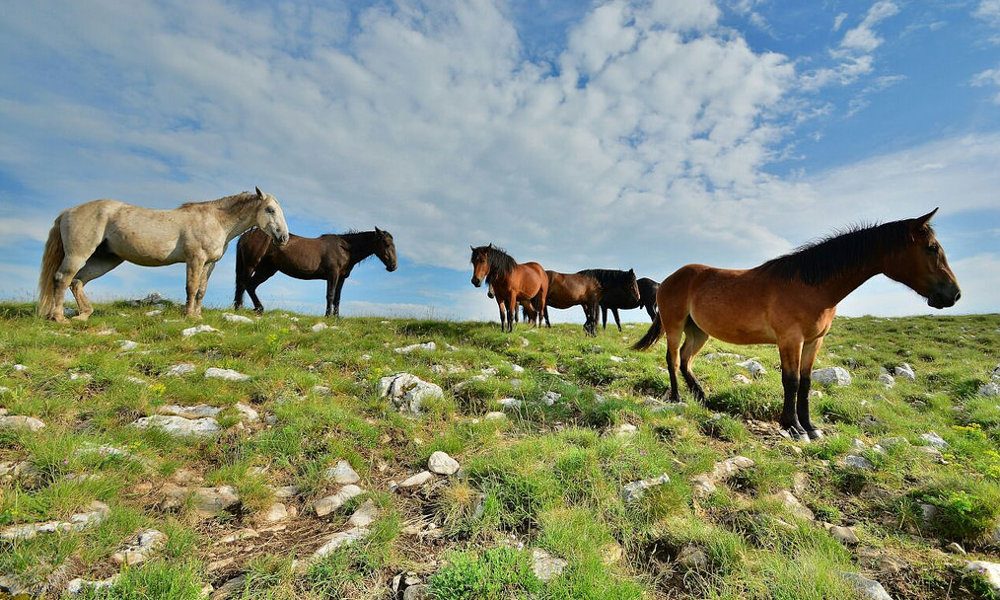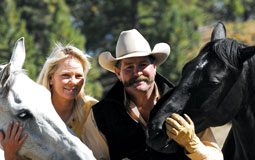
Good leaders create structure and rules, then enforce them fairly. When it comes to being a good leader for your horse, make sure you have set rules about your personal space and enforce them consistently. It’s when your rules change and your corrections aren’t consistent that your horse becomes “untrained” or acts worried in a new location. If you, the human, aren’t the leader, the horse wonders if he should lead. He worries that he needs to be on the lookout for trouble.
Survival by Vigilance
Watching and Worried
This hyper-vigilant tendency is great to have in the herd, but is a troublesome quality for domestic horses. In a new location with lots of new sights to see, a hyper-vigilant horse doesn’t know what to do if his handler isn’t an obvious and strong leader.
With 20 horses in the arena at my clinics, most get right to work, some search and call for their friends, and a few get worked up—to the point of meltdown. The most troubled horse appears agitated; he looks in one direction, then quickly in another. He’s watching everything.
The worried horse bumps into his owner—over and over. He fidgets, pushes, and pulls. His behavior escalates and he seems uncontrollable. The owner is embarrassed. “He doesn’t act like this at home,” she repeats.
The combination of being in a new place and not having strong leadership to let him know he is safe there is too much to handle.
The Trainer Steps In
If a horse is acting up, the owner is usually excited to hand him over. It’s not that I can magically do something different than the owner can do, but I don’t have a complicated relationship history with the horse.
I can step in and show my confidence and teach my rules and enforce them consistently right away. Within five minutes, the once-frantic horse can stand quietly with his head down—showing he’s relaxed when a leader is present.
What do I do when I take the lead? I first teach the horse that I have boundaries and he is not to infringe upon my personal space. He may not move into my space, he may not look around to find something to worry about.
Outfitted in a rope halter and long lead and with a boundary stick or flag in hand, I mark out my space and teach him where he can and cannot be. In just seconds, he’ll learn that he can’t come into my space; if he does he’ll quickly be driven away.
I ask the horse to stand still and calm down. He must stand still without moving his head to look for more distractions to be worried about.
I ask the horse to stand with his nose in front of his chest. If he moves his nose past the corners of his chest, there’s a consequence. I snap the rope so that the knot touches his chin if he moves out of place.
Note: Being a good leader doesn’t mean being harsh or the ultimate dictator. If you set your expectations and you’re consistent, you shouldn’t need to be harsh. If you expect your horse to stand still, correct him each time he takes a step or moves his nose. He’ll quickly learn just how far he can or can’t turn his head, and he’ll know what you’re asking.
However, if a horse has been allowed to push into you, that’s a dangerous behavior. You must use just the pressure needed to move him from your space.
Extra Eyes
Once the horse has calmed down, it’s time to teach the owner how to follow through on the newly set rules. Often just talking about posture and confidence changes the owner’s actions immediately. It’s also helpful to watch how others interact with their horses and see what happens when the horse is allowed to get away with even tiny infractions.
Consider taking a video of yourself working with your horse. What do you notice about your posture and how often your horse steps into your space or looks around?
You may also enlist the help of a friend—a horse person or not—and tell them what to watch for. Were your shoulders back? Did you set your rules and correct consistently? Did you confidently look where you wanted to go while leading your horse? Or did you look back to check on what your horse was doing? A confident leader doesn’t need to look back, but shows the way.
When you create boundaries and follow through with kind-but-consistent corrections, your horse finds security. Your horse will want to please you when he knows you are the leader, and it’s an amazing relationship to have when your horse respects you.
This article originally appeared in the November 2017 issue of Horse Illustrated magazine. Click here to subscribe!





